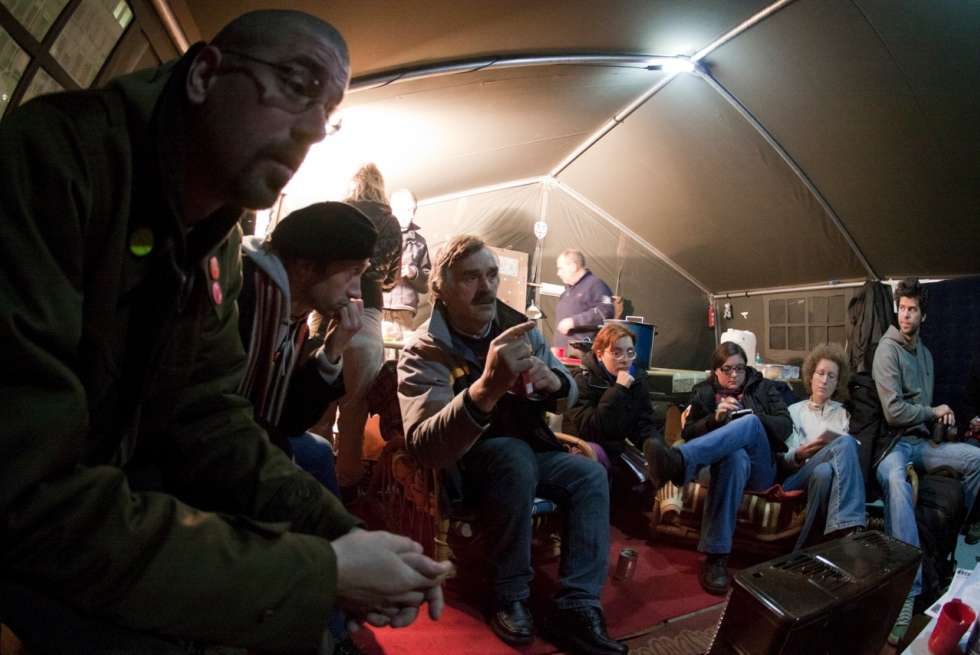Humor and Occupy Wall Street
From the Series: Occupy, Anthropology, and the 2011 Global Uprisings
From the Series: Occupy, Anthropology, and the 2011 Global Uprisings

“Clowns arrested in near-successful attack on Wall Street bull,” announced the headline on the Yes Men’s website (Bichlbaum 2011). The related story describes two clowns in purple and green wigs and colorful clothing who jumped over the barricades protecting Wall Street’s landmark gold bull, danced into Bowling Green Plaza, and tried to climb onto the bull before they were arrested. Nearby, a costumed toreador twirling a red cape walked down the street and leaped atop a police car. A Yes Lab video of these November 2011 capers signs off with “Enough of this bull. #Occupy Wall Street."
Occupy Wall Street’s public face is usually more serious than depicted by the “culture jammers” or “identity correctors” known as the Yes Men (Andy Bichlbaum, Mike Bonnano and Bob Spunkmeyer, http://www.theyesmen.org). Humor, however, is both a personal restorative or morale booster for Occupy participants and part of the movement’s expanding protest repertoire.
“Oh, it’s a funny movement,” an Occupier said wryly in answer to my question about the role of humor in Occupy Wall Street. I spoke with him one Sunday evening last March—the day after the movement’s six-month anniversary—as he and a few other protesters gathered around the perimeter of Liberty Square (Zuccotti Park). Barricades and police officers prevented people from entering the park, where more than 70 had been arrested and many injured by police during a peaceful spring celebration the previous night (Maurer and Natale 2012).
“Levity brings so many forces that are otherwise buried under frustration, under the hard knocks of life,” my interlocutor continued. “If you have a moment of humor it shifts the dialogue,” and “being able to crack a joke and get people to draw on their own sense of what is right is very powerful.”
Clown Brigade members, he said, “trained” Occupiers in the park in a bit of protest “choreography” the previous evening: “We had a group of 20-30 people actively engaging in learning a vocabulary of ‘hop.’ Everyone would skip to the center and hop and then all melt to the ground.” They would stand up again, he said, and someone would shout “Wall West!” and then “everyone would make a wall, one foot forward, lock arms, facing west. [Then] Wall South!” They also practiced “syncopated swimming—get on our backs and open, close, left, right.” A man standing near us as we talked quipped, “is that why they had to clean the park this morning? All those melted people?” Festive direct action “trainings” like these, a participant later explained to me, “teach people to act in concert and allow us to move better as a collective when we’re confronted by police.”
Outside the Waldorf-Astoria a few days earlier, where a fund raiser for Mitt Romney was underway, elegantly attired demonstrators calling themselves “Multi-Millionaires for Mitt”—successors to satirical activists I have studied since 2004—waved placards declaring “Corporations Are People Too!” and chanted “We’re here, we’re rich, get used to it” (Goodwin 2012; see also Haugerud 2012, 2013). A few months earlier, “Billionaires for the One Percent” and “Billionaires for Plutocracy”—clad in tiaras, evening gowns, and tuxedoes—had appeared at Liberty Plaza bearing signs declaring “It’s a Class War, and We’re Winning!” and “Buy Your Own Democracy!” Meanwhile, other Occupy protesters dressed as the Grim Reaper carried “job cutter” scythes and black urns labeled “job cremation.”
Political culture jamming, as these examples illustrate, can disrupt politicians’ branding messages (e.g., about job creators and freedom) and destabilize dominant corporate and discursive frames as they expose contradictory meanings. Theorists of political humor debate whether it serves as a dress rehearsal for other forms of rebellion or as a safe release for aggression against concentrations of power.
Whatever the effects, humor and play have long been part of social movement repertoires. The Yippies “levitated” the Pentagon in 1967, and participants in global movements for social justice during the 1990s and early 2000s donned sea turtle costumes and marched alongside protestors holding giant puppets. Occupy Wall Street has staged “couch-ins” at Bank of America branches to protest mortgage foreclosures, and a March 2012 meeting of Occupy organizers in a Greenwich Village church basement was interrupted at a testy moment with calls of “Clown check!” to announce the actual appearance of singing and dancing clowns—a sure way to diffuse tension in a working group meeting (Schneider 2012). Watch for more humor as Occupy evolves.
Bichlbaum, Andy. 2011. "Clowns Arrested in Near-Successful Attack on Wall Street Bull." Yes Lab Blog, November 9. http://yeslab.org/bull, accessed March 25, 2012.
Goodwin, Liz. 2012 "Multimillionaires for Mitt: Occupy Protesters Stake out Romney NYC Fundraising Event." Yahoo! News, March 14. http://news.yahoo.com/blogs/ticket/multimillionaires-mitt-occupy-protesters-stake-romney-nyc-fundraising-182623833.html, accessed March 31.
Haugerud, Angelique. 2012. "Satire and Dissent in the Age of Billionaires." Social Research: An International Quarterly 79(1): 145-168.
———. In press. Leave No Billionaire Behind: Satirical Activism in America. Stanford, CA: Stanford University Press.
Maurer, Daniel, and Michael Natale. "2012 Head Meets Glass Door during Occupy Wall Street Arrests." New York Times, Local East Village Blog, March 19.http://eastvillage.thelocal.nytimes.com/2012/03/19/the-day-24/, accessed March 31.
Schneider, Nathan. "2012 Paint the Other Cheek." The Nation, March 14.http://www.thenation.com/article/166820/paint-other-cheek, accessed March 31.
Angelique Haugerud is editor of American Ethnologist and Associate Professor of Anthropology at Rutgers, The State University of New Jersey. She is the author of a forthcoming book on satirical activism and the cultural politics of wealth inequality in the United States, and she has published works on political and economic change in East Africa and on globalization.